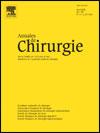Incidence des ruptures sphinctériennes dans l'incontinence anale : étude échographique - 01/01/00
H. Damon 1 , L. Henry 1 , P.J. Valette 1 , F. Mion 1
Mostrare le affiliazioniRiassunto |
But : Évaluer l'incidence des défects échographiques en cas d'incontinence anale.
Patients et méthodes : Soixante-douze patients consécutifs (dix hommes, 62 femmes, d'âge moyen 55 ans) ayant une incontinence anale ont été explorés par échographie endo-anale (Bruel et Kjaer). Parmi ceux-ci, 22 avaient des antécédents de chirurgie proctologique (groupe I) et 50 (46 femmes, quatre hommes) n'avaient pas d'antécédent de chirurgie proctologique (groupe II).
Résultats : L'échographie endo-anale a mis en évidence un défect sphinctérien chez 50 patients (69,4 %) : six défects isolés du sphincter interne (12 %) 18 défects isolés du sphincter externe (36 % ), 26 défects combinés (52 %). L'incidence des défects était similaire dans les groupes I et II (81,8 % contre 64 %, p > 0,05). La presque totalité des défects isolés du sphincter interne étaient trouvés dans le groupe I. Parmi les 46 patientes non opérées, la notion de forceps n'était pas associée à un nombre supérieur de défects (72 % contre 64 %, p > 0,05).
Conclusion : Cette étude confirme l'incidence importante des défects échographiques en cas d'incontinence anale. Les lésions isolées du sphincter interne sont essentiellement trouvées en cas d'antécédent de chirurgie proctologique. Lorsqu'il n'y a pas d'antécédent de chirurgie proctologique, le forceps n'est pas apparu comme facteur de risque de rupture sphinctérienne.
Mots clés : défect sphinctérien ; endosonographie anale ; incontinence anale.
Abstract |
Study aim: To assess the incidence of endosonographic anal sphincter defects in a population of patients complaining of anal incontinence.
Patients and methods: Seventy two consecutive patients (10 men, 62 women, mean age: 55 years) with anal incontinence underwent transanal sonography. In this series, 22 patients had a history of anal surgery (group I), while 50 patients (46 parous women, 4 men) had not been previously operated (group II).
Results: Fifty patients (69.4%) had an anal sphincter defect identified on transanal sonography: 6 isolated internal sphincter defects (12%), 18 isolated external sphincter defects (36%) and 26 combined sphincter defects (52%). The incidence of sphincter defects was similar in the surgical and medical group (81.8% vs 64%, p > 0.05). All but one of the isolated internal sphincter defects were observed in group I. Among the 46 parous women of group II, the use of forceps was not associated with a significantly higher frequency of anal sphincter defects (72% vs 64%, p > 0.05).
Conclusion: This study confirms the high incidence of endosonographic anal sphincter defects in patients with anal incontinence. Isolated lesions of the internal sphincter are mainly seen after anal surgery. In our group of parous women, the use of forceps did not increase the incidence of anal sphincter lesions.
Mots clés : anal endosonography ; anal incontinence ; sphincter defect.
Mappa
Vol 125 - N° 7
P. 643-647 - Settembre 2000 Ritorno al numeroBenvenuto su EM|consulte, il riferimento dei professionisti della salute.

